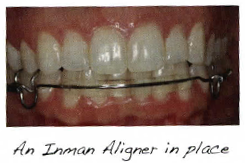Innovations in Aligning Teeth: The Inman Aligner
Written by Ross Nash, DDS Last modified on March 21, 2018
In today’s edition of ASK THE EXPERT, Dr. Nash answers a number of questions related to crowding of the front teeth, with a special focus on the Inman Aligner.
Q. Is there a way to improve the appearance of crowding in the front teeth without the use of dental braces?

A. Yes. If you’re looking for an alternative to braces for remedying crowding of the front teeth, direct composite resin bonding or porcelain veneers can do the trick. However, it’s important to note that both of these alternative approaches typically require reshaping some (or all) of the front teeth first. With that in mind, It’s often more conservative (and less invasive) to move the teeth slightly before considering bonding or veneers. Sometimes, no additional treatment is needed after the teeth are better alignment.
Q. Is there a way to straighten my front teeth w/out the traditional wire and bracket braces?
A. Yes. There are several techniques used today that can provide rapid tooth movement without the need of conventional wire-and-bracket braces. One such treatment that I’m a fan of is the Inman Aligner. Unlike some other techniques like removable clear aligners that utilize a number of different appliances worn in sequence over a period of months, the Inman Aligner is a single appliance worn until the teeth are in the correct position. The Inman Aligner is removable, meaning it can be taken out for meals, cleaning, etc.
Q. How long does it take to straighten front teeth with the Inman Aligner?

A. In my experience, the average treatment time for Inman Aligners tends to be two-to-three months for most suitable cases.
Q. Is the Inman Aligner Expensive?
A. Treatment with an Inman Aligner is one of the most affordable orthodontic procedures available. Average pricing can be compared to the cost of a single porcelain veneer or the cost of a full dental crown.
Q. Will I be required to wear a retainer after my teeth are straightened?
A. “Required” might not be the most appropriate phrasing, but most people do elect to have a bonded wire retainer placed on the inside of the teeth to keep them from relapsing. Alternatively, a conventional removable retainer can be used instead.


